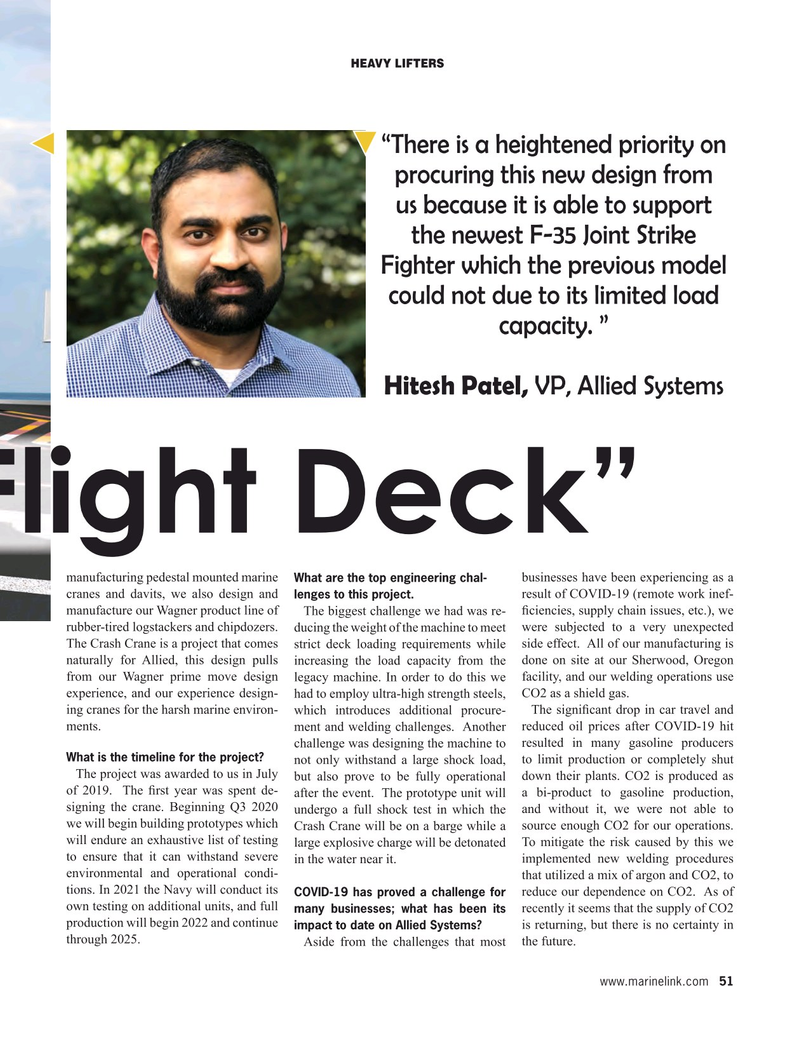
Page 51: of Maritime Reporter Magazine (August 2020)
The Shipyard Edition
Read this page in Pdf, Flash or Html5 edition of August 2020 Maritime Reporter Magazine
HEAVY LIFTERS “There is a heightened priority on procuring this new design from us because it is able to support the newest F-35 Joint Strike
Fighter which the previous model could not due to its limited load capacity. ”
Hitesh Patel, VP, Allied Systems
Flight Deck” manufacturing pedestal mounted marine businesses have been experiencing as a
What are the top engineering chal- cranes and davits, we also design and result of COVID-19 (remote work inef- lenges to this project. manufacture our Wagner product line of The biggest challenge we had was re- ? ciencies, supply chain issues, etc.), we rubber-tired logstackers and chipdozers. ducing the weight of the machine to meet were subjected to a very unexpected
The Crash Crane is a project that comes strict deck loading requirements while side effect. All of our manufacturing is naturally for Allied, this design pulls increasing the load capacity from the done on site at our Sherwood, Oregon from our Wagner prime move design legacy machine. In order to do this we facility, and our welding operations use experience, and our experience design- had to employ ultra-high strength steels, CO2 as a shield gas. ing cranes for the harsh marine environ- which introduces additional procure- The signi? cant drop in car travel and ments. ment and welding challenges. Another reduced oil prices after COVID-19 hit challenge was designing the machine to resulted in many gasoline producers
What is the timeline for the project? not only withstand a large shock load, to limit production or completely shut
The project was awarded to us in July but also prove to be fully operational down their plants. CO2 is produced as of 2019. The ? rst year was spent de- after the event. The prototype unit will a bi-product to gasoline production, signing the crane. Beginning Q3 2020 undergo a full shock test in which the and without it, we were not able to we will begin building prototypes which
Crash Crane will be on a barge while a source enough CO2 for our operations. will endure an exhaustive list of testing large explosive charge will be detonated To mitigate the risk caused by this we to ensure that it can withstand severe in the water near it. implemented new welding procedures environmental and operational condi- that utilized a mix of argon and CO2, to tions. In 2021 the Navy will conduct its reduce our dependence on CO2. As of
COVID-19 has proved a challenge for own testing on additional units, and full recently it seems that the supply of CO2 many businesses; what has been its production will begin 2022 and continue is returning, but there is no certainty in impact to date on Allied Systems?
through 2025.
Aside from the challenges that most the future.
www.marinelink.com 51
MR #8 (50-58).indd 51 8/9/2020 10:08:14 PM

 50
50

 52
52
